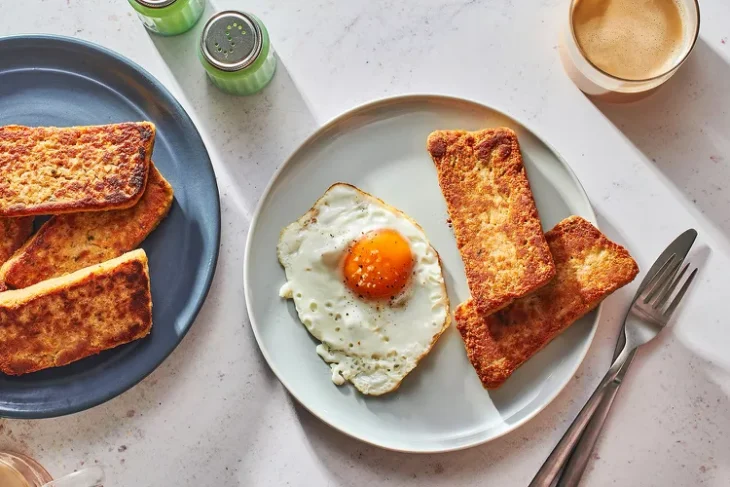
Scrapple is a traditional dish that holds a special place in the hearts of many. With its crispy exterior and savory flavor, it has become a breakfast staple in certain regions. But what lies beneath its golden crust? In this article, we will explore eleven scrapple nutrition facts, unveiling the calories, macronutrients, and other essential information that makes this traditional delicacy a unique culinary experience. Join us as we embark on a journey through the world of scrapple, discovering its nutritional profile along the way.
Calorie Content
Scrapple is a relatively calorie-dense food. A typical serving of scrapple (4 ounces) can range from around 180 to 220 calories. It’s important to consider portion sizes when managing your calorie intake.
Protein Powerhouse
One of the notable characteristics of scrapple is its protein content. A serving of scrapple can provide approximately 9 to 12 grams of protein, making it a moderate source of this essential macronutrient.
Fat Content
Scrapple can be higher in fat compared to some other breakfast options. A serving typically contains around 10 to 15 grams of fat. It’s worth noting that the fat content may vary depending on the specific recipe and cooking method.
Carbohydrate Contribution
While scrapple is often associated with its protein and fat content, it also contains carbohydrates. A serving generally provides around 10 to 15 grams of carbohydrates, contributing to its overall caloric content.
Sodium Levels

One aspect to be mindful of when consuming scrapple is its sodium content. Due to the seasoning and processing involved in its preparation, scrapple can be relatively high in sodium. A serving may contain around 400 to 600 milligrams of sodium.
Iron Boost
Scrapple can contribute to your daily iron intake. A serving typically provides around 10% to 15% of the recommended daily intake of iron, depending on the specific brand or recipe.
Micronutrient Variations
The exact micronutrient profile of scrapple can vary depending on the specific recipe and brand. It can provide small amounts of various vitamins and minerals, including vitamin B12 and zinc.
Cooking Methods
Scrapple can be prepared in various ways, including pan-frying or grilling. The cooking method you choose can affect the texture and overall taste of the scrapple, allowing you to personalize your culinary experience.
Regional Delicacy
Scrapple is often associated with specific regions, particularly in the Mid-Atlantic area of the United States. It has deep roots in Pennsylvania Dutch and Pennsylvania German cuisine, where it has been enjoyed for generations.
Versatile Ingredient
While scrapple is commonly consumed on its own as a breakfast item, it can also be a versatile ingredient in various recipes. It can be sliced and used as a topping for sandwiches or incorporated into dishes like casseroles or stuffing.
Culinary Appreciation
Scrapple is a unique delicacy that evokes nostalgia and a sense of tradition for many. Its rich flavors and crispy texture have garnered a dedicated following, making it a beloved choice for breakfast enthusiasts.
Conclusion
In conclusion, scrapple is a traditional delicacy that offers a distinct culinary experience. While it can be calorie-dense and relatively high in sodium, it also provides protein, fats, and other nutrients. Enjoy scrapple in moderation as part of a balanced diet, savoring the flavors and embracing the cultural heritage associated with this regional favorite.
Frequently Asked Questions (FAQs)
What is scrapple made of?
Scrapple is typically made from pork scraps, such as the head, liver, and other trimmings. These scraps are combined with cornmeal and spices to create the unique flavor and texture of scrapple.
Is scrapple gluten-free?
Scrapple traditionally contains cornmeal, which is gluten-free. However, it’s important to check the specific brand or recipe to ensure that no wheat-based ingredients are used in the preparation.
Can scrapple be frozen for later consumption?
Yes, scrapple can be frozen for later use. It’s advisable to slice it into individual portions before freezing and then thaw and cook as desired when you’re ready to enjoy it.
Is there a vegetarian or vegan version of scrapple?
While traditional scrapple is made from pork scraps, there are vegetarian and vegan alternatives available that use plant-based ingredients, such as grains and spices, to mimic the texture and flavor of the original dish.
How should scrapple be stored?
Scrapple should be stored in the refrigerator in an airtight container or wrapped tightly in plastic wrap. Proper storage helps maintain its freshness and prevents bacterial growth.
Was this page helpful?
Our commitment to delivering trustworthy and engaging content is at the heart of what we do. Each fact on our site is contributed by real users like you, bringing a wealth of diverse insights and information. To ensure the highest standards of accuracy and reliability, our dedicated editors meticulously review each submission. This process guarantees that the facts we share are not only fascinating but also credible. Trust in our commitment to quality and authenticity as you explore and learn with us.
